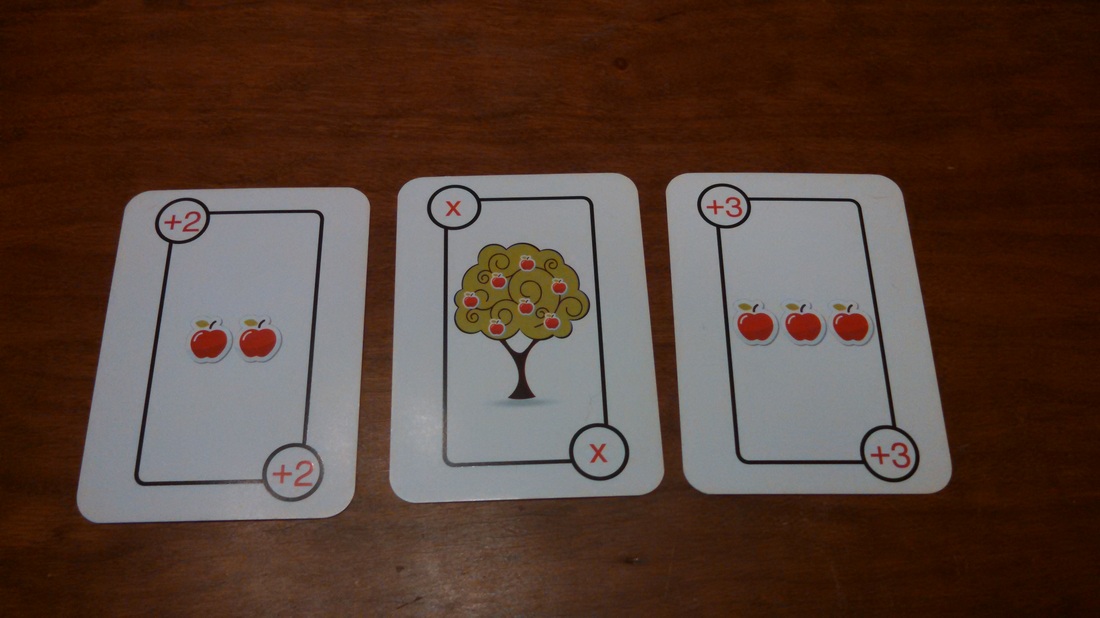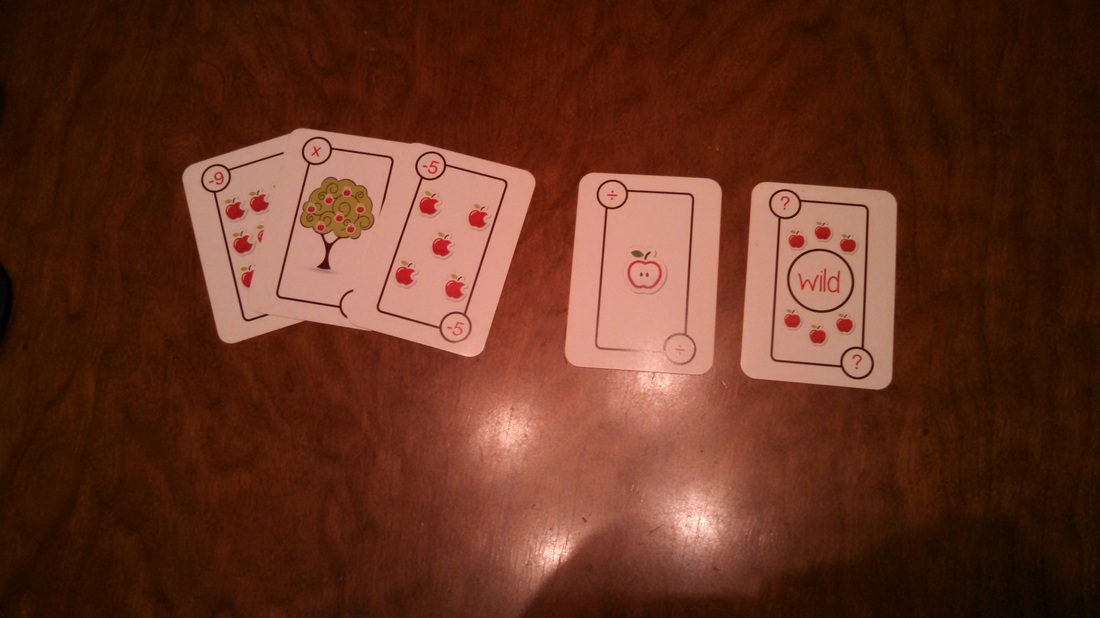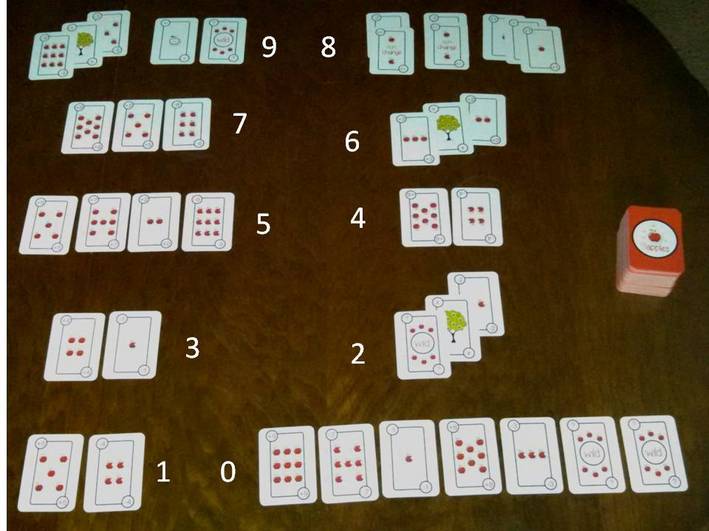Needs: 9 Apples Base Game and 9 Apples Booster Pack
Age Level: Grade 3
Learning Objectives: Understand the concept of division: what does division really mean and how we may visualize a division problem. Describe why knowing how to divide numbers is important.
By now our students are likely beginning to understand and feel comfortable with multiplication. The good news is that division is a natural extension of multiplication...if we remember our multiplication tables, we can generally come up with the answer to a division problem using the same numbers. But what does it really mean to “divide” numbers? Once again we have the opportunity to teach a deeper concept, as well as help our students understand why this is important.
If we let Merriam-Webster’s Dictionary define division for us, we see that in mathematics division is, “the process of finding out how many times one number is contained in another”. For a more visual definition, we can begin to think about dividing a number of apples into a number of baskets or shopping bags.
Let’s say we are selling apples at a local farmers’ market. We have 50 apples to sell, and all at once we get five customers. We sell the same number of apples to all five customers, and when we are finished we have only ten apples left. How many apples did we sell to each customer? This is a great example of a real-world division problem! We can use our 9 Apples cards to demonstrate this idea visually, and make it more clear to our students.
Let’s begin by our cards, face down, to represent the apples. We begin with 50 apples at our apple stand:
Age Level: Grade 3
Learning Objectives: Understand the concept of division: what does division really mean and how we may visualize a division problem. Describe why knowing how to divide numbers is important.
By now our students are likely beginning to understand and feel comfortable with multiplication. The good news is that division is a natural extension of multiplication...if we remember our multiplication tables, we can generally come up with the answer to a division problem using the same numbers. But what does it really mean to “divide” numbers? Once again we have the opportunity to teach a deeper concept, as well as help our students understand why this is important.
If we let Merriam-Webster’s Dictionary define division for us, we see that in mathematics division is, “the process of finding out how many times one number is contained in another”. For a more visual definition, we can begin to think about dividing a number of apples into a number of baskets or shopping bags.
Let’s say we are selling apples at a local farmers’ market. We have 50 apples to sell, and all at once we get five customers. We sell the same number of apples to all five customers, and when we are finished we have only ten apples left. How many apples did we sell to each customer? This is a great example of a real-world division problem! We can use our 9 Apples cards to demonstrate this idea visually, and make it more clear to our students.
Let’s begin by our cards, face down, to represent the apples. We begin with 50 apples at our apple stand:
We know we are left with 10 apples at the end, so we know we have sold 50 - 10 = 40 apples. So our first task is to remove 10 apples, leaving the 40 sold apples.
We also know that each of five customers purchased the same number of apples. This means we must divide 40 apples equally among our five customers. This becomes the equation 40 ÷ 5.
We know from our multiplication tables that 8 x 5= 40 (this may be a good time to remind our students of their multiplication tables, and ask what times 5 equals 40). Now we can ask our students to group their 40 apples into equal piles for each customer. There should be 8 apples in each of 5 piles.
We know from our multiplication tables that 8 x 5= 40 (this may be a good time to remind our students of their multiplication tables, and ask what times 5 equals 40). Now we can ask our students to group their 40 apples into equal piles for each customer. There should be 8 apples in each of 5 piles.
Let’s try another problem: What if we have 80 apples at our stand, and we have 9 customers. What is the most apples can we sell, and still give each customer the same number of apples? How many apples will we have left?
We may begin with 80 cards face down (this is a good opportunity to show your students how important knowing division is...80 cards will get quite cumbersome! You wouldn't want to use this method with very large numbers.). We now must divide this number of apples into 9 equal piles, giving each customer the maximum number of apples while still giving each the same number of apples. We’ll begin by asking what is 80 ÷ 9? If we actually calculate this equation, we find that 80 ÷ 9 = 8.88. This means we do not have enough apples to divide them all equally between 9 customers. Since this number is between 8 and 9, we can sell each customer 8 apples, and will have some left over. If we divide our apples into 9 equal piles of 8, how many are we left with? We know from our multiplication tables that 8 x 9 = 72, therefore we will have 8 apples left (80 - 72 = 8).
Now that your students understand what division is, and why it’s so important, help them practice their skills in dividing numbers by playing the 9 Apples Base Game with Booster Pack! See a tutorial on how to play by clicking here.
We may begin with 80 cards face down (this is a good opportunity to show your students how important knowing division is...80 cards will get quite cumbersome! You wouldn't want to use this method with very large numbers.). We now must divide this number of apples into 9 equal piles, giving each customer the maximum number of apples while still giving each the same number of apples. We’ll begin by asking what is 80 ÷ 9? If we actually calculate this equation, we find that 80 ÷ 9 = 8.88. This means we do not have enough apples to divide them all equally between 9 customers. Since this number is between 8 and 9, we can sell each customer 8 apples, and will have some left over. If we divide our apples into 9 equal piles of 8, how many are we left with? We know from our multiplication tables that 8 x 9 = 72, therefore we will have 8 apples left (80 - 72 = 8).
Now that your students understand what division is, and why it’s so important, help them practice their skills in dividing numbers by playing the 9 Apples Base Game with Booster Pack! See a tutorial on how to play by clicking here.












































 RSS Feed
RSS Feed
